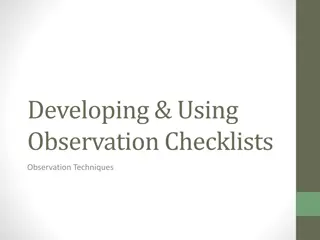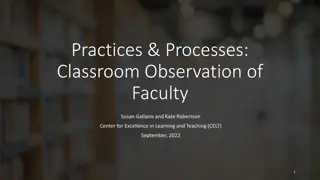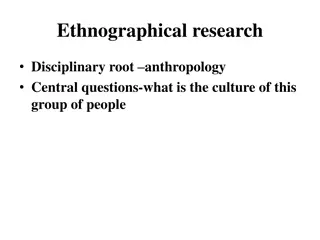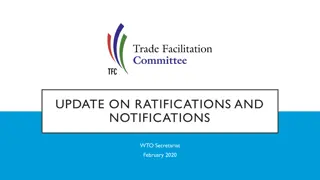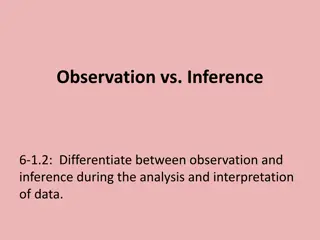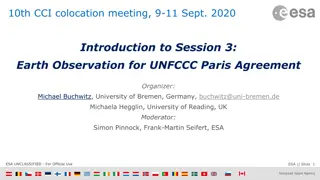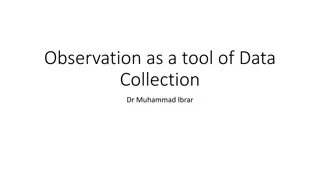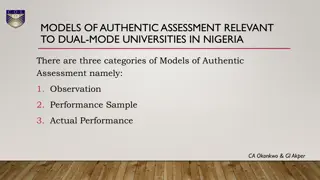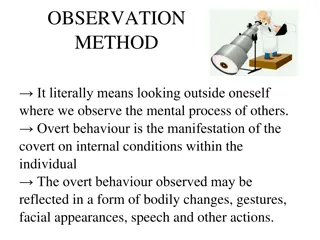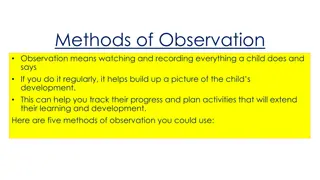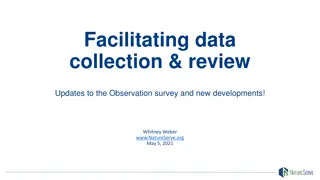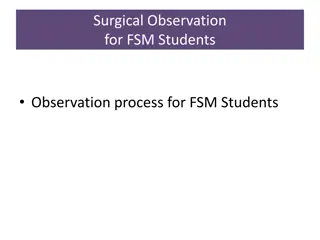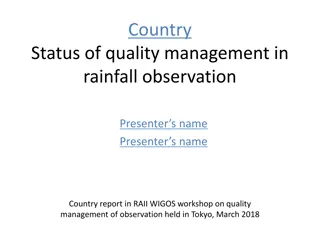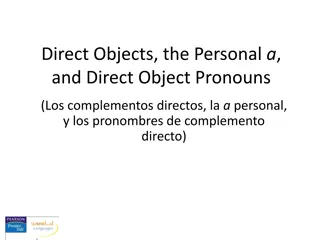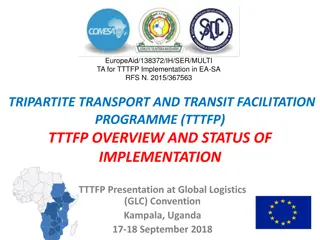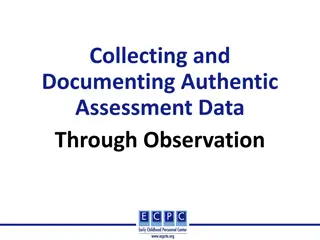Utilizing Direct Observation for Implementation Facilitation
This article discusses the importance of direct observation in guiding implementation facilitation processes. It emphasizes the value of formative evaluation to identify influences on implementation effectiveness. By thoroughly collecting data through mixed-methods direct observation, facilitators can shape the implementation process by systematically feeding the data back. Direct observation allows for a strategic method of data collection, enabling researchers to understand processes, events, norms, and values in complex contexts. Four types of formative evaluation are outlined, emphasizing understanding, detailing activities, monitoring impact, and explaining results in implementation-focused contexts.
Download Presentation

Please find below an Image/Link to download the presentation.
The content on the website is provided AS IS for your information and personal use only. It may not be sold, licensed, or shared on other websites without obtaining consent from the author. Download presentation by click this link. If you encounter any issues during the download, it is possible that the publisher has removed the file from their server.
E N D
Presentation Transcript
Using Direct Observation to Guide Implementation Facilitation Bo Kim PhD1,2, Christopher J. Miller PhD1,2, Mark S. Bauer MD1,2, A. Rani Elwy PhD1,3 (1) HSR&D Center for Healthcare Organization and Implementation Research; Veterans Health Administration (2) Department of Psychiatry; Harvard Medical School (3) Department of Health Law, Policy, and Management; Boston University School of Public Health
Direct observation Implementation Formative through evaluation facilitation
Formative Evaluation (FE) From Stetler et al. (2006): A rigorous assessment process designed to identify potential and actual influences on the progress and effectiveness of implementation efforts Challenge inaccurate but still widespread view that FE involves only qualitative research or that it is not rigorous
Thoroughly collect implementation data Mixed-methods direct observation Implementation Formative through evaluation facilitation Systematically feed the data back to shape implementation
Direct Observation observation is about stalking culture in the wild [it] is a strategic method [which] puts you where the action is and lets you collect data . . . (Bernard, 2002) World Health Organization s Kikwawila Study Group, 1994: To understand processes, events, norms, values, and social context human behavior that is largely unknown (hidden) or complex conceptions and attitudes of study group and their points of view To complement other findings To help researcher formulate ideas in local language
Four types of FE (Stetler et al., 2006): Understanding practice Detailing activities Monitoring impact Explaining results Implementation- focused Developmental Progress-focused Interpretive To understand processes, events, norms, values, and social context human behavior that is largely unknown (hidden) or complex conceptions and attitudes of study group and their points of view To complement other findings To help researcher formulate ideas in local language
Acknowledgements McCullough MB, Kim B, Ruben M, Wang S, Fix GM. Direct Observation Methods for Health Services and Implementation Research. AcademyHealth Annual Research Meeting, Boston, 26-28 June 2016. The contents do not represent the views of the U.S. Department of Veterans Affairs (VA) or the United States Government. This work is supported by VA HSR&D Quality Enhancement Research Initiative QUE 15-289, Behavioral Health QUERI Program, Hybrid Controlled Trial to Implement Collaborative Care in General Mental Health. Authors have no conflicts of interest.
Implementation Study: Multi-site stepped-wedge controlled trial to implement interdisciplinary team- based behavioral health care at VA medical centers Conceptual Framework: Integrated Promoting Action on Research Implementation in Health Services (i-PARIHS) framework (Harvey & Kitson, 2016) Facilitation Model: Blended external-internal facilitation (Kirchner et al., 2014)
Population Involved Three external facilitators (EFs) Each EF worked with the internal facilitator (IF) at three sites (N=9 sites) Each site s interdisciplinary team of providers Each site s additional stakeholders including leadership
Observation Parameters DOMAIN: information that observation is providing OBSERVER: who is observing SUBJECT: who is being observed MODE: how observation is being carried out TIMING: when observation is being carried out DATA COLLECTION AID FORMATIVE FEEDBACK MECHANISM
Observation DomainsConsidered 4-6 weeks prior to year-long implementation facilitation During year-long implementation facilitation Site Implementation Status Resource Utilization Characteristics -Time-motion log of facilitation activity -Count and progress check of redesigned processes -Semi-structured conversations -Comparison across sites -Multi-modal observations of team meetings -Multi-modal observations during site visit
Observation Domain: Site Characteristics Developmental OBSERVER EF SUBJECT IF, team, stakeholders MODE EF holds phone/video/on-site conversations with IF, team, and stakeholders TIMING Pre-implementation period of approximately six weeks
Observation Domain: Site Characteristics Developmental DATA COLLECTION AID: i-PARIHS-based conversation guide Sample questions: What external context factors (e.g., high rates of homelessness in surrounding area, recent layoffs among the patient population) should we be aware of? Is there a history of multidisciplinary collaboration among staff? If so, how would you describe it? What is your experience with, or knowledge of, the interdisciplinary team-based care initiative? FORMATIVE FEEDBACK MECHANISM: Baseline site assessment report
Implementation- focused Observation Domain: Implementation Status Progress-focused OBSERVER EF, IF SUBJECT EF, IF, team MODE EF joins IF-led team meeting over video TIMING IF leads team meeting weekly; EF joins regularly for first half of year- long implementation period, then with tapering frequency over second half
Implementation- focused Observation Domain: Implementation Status Progress-focused DATA COLLECTION AID: i-PARIHS-based coordination document Notes from implementation team meeting Implementation progress and relevant considerations Follow-up tasks review Draft meeting agenda FORMATIVE FEEDBACK MECHANISM: Weekly phone calls between EF and IF
Implementation- focused Observation Domain: Resource Utilization Progress-focused OBSERVER EF SUBJECT EF MODE EF logs facilitation activities and time spent on each activity TIMING Pre-implementation period, then two weeks each towards beginning, middle, and end of implementation period
Implementation- focused Observation Domain: Resource Utilization Progress-focused DATA COLLECTION AID: i-PARIHS-based time-motion tracker FORMATIVE FEEDBACK MECHANISM: Quarterly comparison across EFs/sites
Observation for Mixed-Methods FE DOMAIN OBSERVER SUBJECT MODE TIMING Site Characteristics EF IF, team, stakeholders EF holds phone/video/on- site conversations with IF, team, and stakeholders Pre-implementation period of approximately six weeks Developmental Implementation Status EF, IF EF, IF, team EF joins IF-led team meeting over video Progress-focused IF leads team meeting weekly; EF joins bi-weekly for first half of year-long implementation period, then with tapering frequency over second half Interpretive Implementation- focused Resource Utilization EF EF EF logs facilitation activities and time spent on each activity Pre-implementation period, then two weeks each towards beginning, middle, and end of implementation period Implementation- focused Progress-focused
Limitations & Next Steps Method s data collection and feedback mechanisms are primarily EF-driven and EF- focused Effectiveness of method in comparison to other formative evaluation approaches Applicability of method to other facilitation within/outside behavioral health / VA
TranslatingResearch into Practice Practice implications for facilitation- driven implementation efforts Generalizable practice implications Direct observation of facilitation allows systematic/replicable collection and regular feedback of data on: Vocalized perceptions/interactions Nonverbal behavior/appearances Care setting/space Team/Clinical processes Utilization of facilitation resources Direct observation methodologies can enable structured collection and utilization of formative evaluation data for other implementation efforts that are non-facilitation-specific Data collection aids and feedback mechanisms can be adopted by implementation recipients for continued self-monitoring and communication with stakeholders to help ensure sustainability Method can help steer facilitation activities toward implementation that fits local and changing contexts
Summary Use of direct observation for formative evaluation of blended implementation facilitation work Organized and coordinated gathering of behavioral, temporal, and contextual data through i-PARIHS-based data collection aids Systematic feedback of data to facilitators through assessment report, EF-IF coordination, and cross-EF/site review
Thoroughly collect implementation data Mixed-methods direct observation Implementation Formative through evaluation facilitation Systematically feed the data back to shape implementation
Objective Implementation facilitation is being increasingly employed to enhance the use of evidence-based approaches in health care delivery Limited established methods for: Thoroughly collecting data on ongoing facilitation experiences Systematically feeding them back to facilitators to help prospectively shape their facilitation activities Aimed to develop/pilot a method for collection/feedback of data based on direct observation of facilitation activities
Formative Evaluation (FE) Current practice Potential barriers/facilitators Project s feasibility & perceived utility Developmental Intervention description Exposure to / Experience of intervention Context of change Implementation- focused Monitoring of impact Movement toward desired outcomes Dose & intensity of implementation effort Progress-focused Results explanation Perceptions, reasons, recommendations Use/Triangulation of formative & summative data Interpretive Stetler et al., 2006
i-PARIHS Revision to the original PARIHS framework (Kitson, 2008), one of the first frameworks to highlight the importance of context and multidimensional complexity of implementing health care practices Successful implementation (SI) is a function of the facilitation (Facn), innovation (I), recipients (R), and context (C): SI = Facn (I + R + C) Facn activates implementation through constantly assessing, aligning, and integrating the other constructs Harvey & Kitson, 2016
Implementation Facilitation From Ritchie et al. (2017) s Implementation Facilitation Training Manual Version 2: A multi-faceted process of enabling and supporting individuals, groups and organizations in their efforts to adopt and incorporate clinical innovations into routine practices Can incorporate or include many other implementation strategies, e.g., audit and feedback, education and training, and stakeholder engagement
Blended Facilitation External Facilitator (EF): Brings the content and process expertise to a site Internal Facilitator (IF): Offers the experience and knowledge of the site s organizational culture and existing procedures Kirchner et al., 2014
Observation Parameters DOMAIN OBSERVER SUBJECT MODE TIMING Site Characteristics EF IF, team, stakeholders EF holds phone/video/on- site conversations with IF, team, and stakeholders Pre-implementation period of approximately six weeks Implementation Status EF, IF EF, IF, team EF joins IF-led team meeting over video IF leads team meeting weekly; EF joins bi-weekly for first half of year-long implementation period, then with tapering frequency over second half Resource Utilization EF EF EF logs facilitation activities and time spent on each activity Pre-implementation period, then two weeks each towards beginning, middle, and end of implementation period




